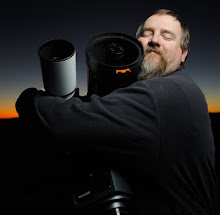So that's what I did. I started researching apochromatic refractors. I've been getting nice shots with the big SCT, but it's limited to smaller targets due to the long focal length, so I'm looking for something with less focal length. I'm also trying to not spend a whole lot of money. So the Tele-Vue NP-101 that I really like is out: $3,700 is way out of my league. The Orion ED80 is a popular choice, and at $600 it's right in my sweet spot. But Barry has one, and while it's a very nice telescope, I want something different. The Meade Series 5000 ED APO triplet looks promising, but I never found an entirely positive review. Finally after a lot of research, I decide on the Astronomy Technologies AT80EDT. It's a triplet design, which means it uses three lenses instead of the usual two. It has a two-speed focuser like the one I added to the LX200, and comes in a nice case.
One Astromart "wanted" ad and a week later I'm the new owner of a nearly new AT80EDT. She's a beauty--white finish with grey, gold and green accents. The views through her are sweet, too. She rides just fine on the big LXD650 mount too. Here she is lit by the first quarter moon:

Friday night was the big night. Barry talked me into going up to the Eagle Eye Observatory for an overnighter, and what a night it was. Fridays are public night at the EEO, and there were about 40 guests there. The observatory operator had his hands full, so Barry & I took up the slack. He had his 10" LX200GPS going, while I put the binoviewers in the AT80EDT and aimed it at the Moon. I love it when someone looks into the scope and exclaims, "Oh my God!"
After the guests left and the Moon set, I hooked up the camera and went to work. I don't have the mount set up for autoguiding yet, so these are kinda rough. Each one is 40 x 30 seconds for just a 20-minute total exposure time. They're enough to get me really excited about imaging with this telescope though. Up first is M31, the Andromeda Galaxy:

Then there's M45, the Pleiades. I somehow managed to pull out some of the blue nebulosity even with the short exposure:

And last is M42, the Orion Nebula. Always a crowd-pleaser:






No comments:
Post a Comment